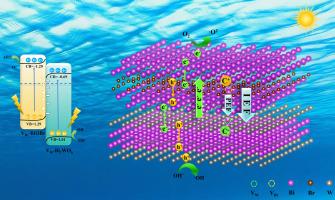Dual vacancies and S-scheme BiOBr/Bi2WO6 heterojunction synergistically boost the directional transfer of photogenerated electrons for efficient photocatalytic degradation of norfloxacin
IF 6.3
2区 工程技术
Q1 ENGINEERING, CHEMICAL
引用次数: 0
Abstract
Defect (vacancy) engineering is a cost-effective and efficient modification strategy for S-scheme heterojunctions. In this work, S-scheme BiOBr/Bi2WO6 heterojunctions with bromine vacancies (VBr) and tungsten vacancies (VW) were prepared by the NaOH etching method. The efficiencies of photodegradation of NOR for the optimal sample, VW+Br-BiOBr/Bi2WO6–3 (VW+Br-BBW), showed approximately 11.5 times improvement over Bi₂WO₆ and 2.7 times over BiOBr. The Br![]() W dual vacancies generated a polarization electric field (PEF) in VW+Br-BBW. The collaboration between the PEF and internal electric field (IEF) facilitated the directional movement of photogenerated electrons, leading to improved separation and migration of photocarriers. Owing to the synergistic effect of dual vacancies and S-scheme heterojunction, VW+Br-BBW showed superior photocatalytic performance for NOR degradation. This work presents a possible approach to incorporating dual vacancies in heterojunctions to enhance photocatalytic performance and emphasizes the pivotal role of defects in constructing the S-scheme system.
W dual vacancies generated a polarization electric field (PEF) in VW+Br-BBW. The collaboration between the PEF and internal electric field (IEF) facilitated the directional movement of photogenerated electrons, leading to improved separation and migration of photocarriers. Owing to the synergistic effect of dual vacancies and S-scheme heterojunction, VW+Br-BBW showed superior photocatalytic performance for NOR degradation. This work presents a possible approach to incorporating dual vacancies in heterojunctions to enhance photocatalytic performance and emphasizes the pivotal role of defects in constructing the S-scheme system.

双空位和 S 型 BiOBr/Bi2WO6 异质结协同促进了光生电子的定向转移,从而实现诺氟沙星的高效光催化降解
缺陷(空位)工程是一种经济有效的 S 型异质结改性策略。本研究采用 NaOH 蚀刻法制备了具有溴空位(VBr)和钨空位(VW)的 S 型 BiOBr/Bi2WO6 异质结。最佳样品 VW+Br-BiOBr/Bi2WO6-3(VW+Br-BBW)的 NOR 光降解效率比 Bi₂WO₆ 提高了约 11.5 倍,比 BiOBr 提高了 2.7 倍。 BrW 双空位在 VW+Br-BBW 中产生了极化电场(PEF)。极化电场和内部电场(IEF)的协同作用促进了光生电子的定向移动,从而改善了光载体的分离和迁移。由于双空位和 S 型异质结的协同作用,VW+Br-BBW 在降解 NOR 方面表现出卓越的光催化性能。这项研究提出了在异质结中加入双空位以提高光催化性能的可行方法,并强调了缺陷在构建 S 型体系中的关键作用。
本文章由计算机程序翻译,如有差异,请以英文原文为准。
求助全文
约1分钟内获得全文
求助全文
来源期刊

Journal of water process engineering
Biochemistry, Genetics and Molecular Biology-Biotechnology
CiteScore
10.70
自引率
8.60%
发文量
846
审稿时长
24 days
期刊介绍:
The Journal of Water Process Engineering aims to publish refereed, high-quality research papers with significant novelty and impact in all areas of the engineering of water and wastewater processing . Papers on advanced and novel treatment processes and technologies are particularly welcome. The Journal considers papers in areas such as nanotechnology and biotechnology applications in water, novel oxidation and separation processes, membrane processes (except those for desalination) , catalytic processes for the removal of water contaminants, sustainable processes, water reuse and recycling, water use and wastewater minimization, integrated/hybrid technology, process modeling of water treatment and novel treatment processes. Submissions on the subject of adsorbents, including standard measurements of adsorption kinetics and equilibrium will only be considered if there is a genuine case for novelty and contribution, for example highly novel, sustainable adsorbents and their use: papers on activated carbon-type materials derived from natural matter, or surfactant-modified clays and related minerals, would not fulfil this criterion. The Journal particularly welcomes contributions involving environmentally, economically and socially sustainable technology for water treatment, including those which are energy-efficient, with minimal or no chemical consumption, and capable of water recycling and reuse that minimizes the direct disposal of wastewater to the aquatic environment. Papers that describe novel ideas for solving issues related to water quality and availability are also welcome, as are those that show the transfer of techniques from other disciplines. The Journal will consider papers dealing with processes for various water matrices including drinking water (except desalination), domestic, urban and industrial wastewaters, in addition to their residues. It is expected that the journal will be of particular relevance to chemical and process engineers working in the field. The Journal welcomes Full Text papers, Short Communications, State-of-the-Art Reviews and Letters to Editors and Case Studies
 求助内容:
求助内容: 应助结果提醒方式:
应助结果提醒方式:


